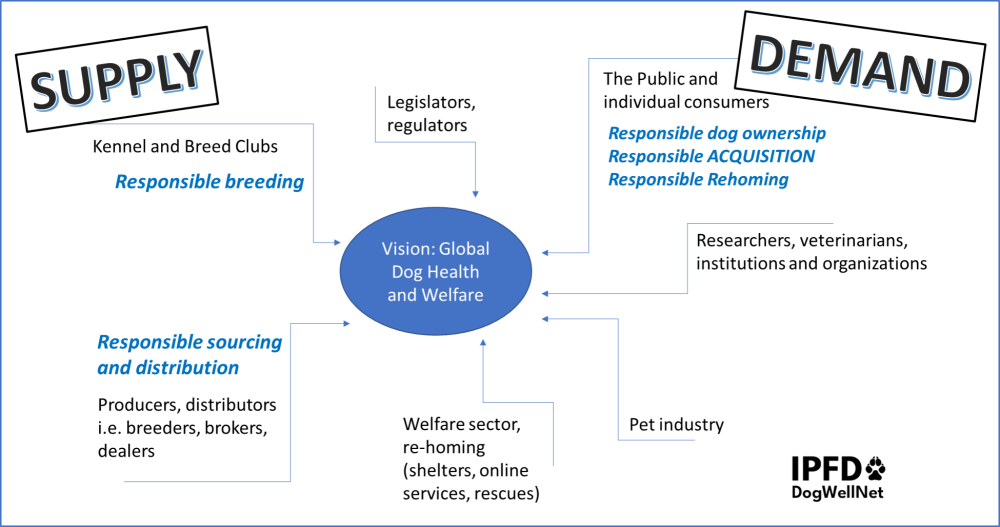Why do legislators address the supply side and not demand?
Why do legislators address the supply side and not demand?
There continue to be reports of legislative and legal approaches and other actions related to the issue of brachycephalic (short-nosed) dogs. The international dog community is closely following the Norwegian legal action against kennel and breed clubs, and individual breeders. A ruling is expected by the end of the month. Issues in the Netherlands are ongoing. [links below].
As I work closely with various groups on the issue of health, well-being, and welfare in dogs, I understand that slow action for change from breeders has prompted legislative actions. But I find myself wondering:
Why do legislators generally attack the supply side and not demand?
 Supply can be defined as the amount of a product that is/would be offered for sale. Supply is created based on voluntary decisions made by producers, but is driven by consumer demands.
Supply can be defined as the amount of a product that is/would be offered for sale. Supply is created based on voluntary decisions made by producers, but is driven by consumer demands.
What are the aspects that relate to dogs, specifically brachycephalic (short-muzzled) dogs?
- Dogs are a commodity. They are bought and sold. Many people who view dogs as sentient beings don’t like this definition. But it is simply a fact, a reality.
-
Commodities (things for sale) operate in a Supply : Demand relationship
- Law of Supply – higher prices, producers increase quantity
- Supply and demand together determine prices, availability, and quantities of most goods
- Increased demand creates an increase in supply. This was seen in the pandemic where all sorts of breeders quickly increased the supply. Pretty sure health testing suffered… and now veterinary services are stretched to the breaking point - an unfortunate consequence (see link below).
- But without demand – supply will drop off.
-
So why then do governments/legislators not act to restrict or prohibit demand/ i.e. ownership – if they are worried that a product – e.g., flat-faced dogs – poses unacceptable health and welfare to the animals? Maybe:
- It would be impossible to enforce.
- It would be unpopular, damaging politically.
-
It would negatively affect a portion of the economy.
- Either the government would lose money directly, or
- The producers reflect an important group, and they would lose money. And majority of these are NOT breeders associated with kennel clubs,. Or,
- Ancillary services might suffer – suppliers of the producers, suppliers to the end user – e.g., pet industry, veterinarians, etc., or…
- All of the above.
But presumably, the public could demand, and the producers supply healthy dogs with good welfare, thereby removing most of those concerns.
OR – perhaps – the rule-makers truly believe it is possible – with the right motivation – to create MODERATE dogs of a non-extreme type. So doting owners can have a Pug or a French Bulldog as long as it is free of the extreme characteristics that represent problems of health and welfare.
If the latter is the case, then If breeders refuse or are unable to comply and create such dogs, then the loss of these breeds would presumably be their responsibility (fault) not the government’s. Of course, as long as restrictions are regional, then owners can get the extreme dogs from elsewhere… and the problem goes on.
Clearly, if public appreciation of health problems and suffering cannot be achieved, and demand continues, it will provoke and maintain a matching supply –
somehow from somewhere.
So now we are back to where the International Partnership for Dogs (IPFD) has always been, i.e., this is a complex problem, involving many stakeholders and without a collective, coordinated, and collaborative approach, solutions will continue to be fractured, less than fully effective – provoking confusion and confrontation. Let's be clear - this is NOT a call for legislation against ownership or for breed bans (see link below). Those responses are unlikely to work. It is a call for collective efforts on a complex problem which involves many stakeholders - on all sides of the problem. Our partner Brachycephalic Working Group has released a consensus statement to address attitudes to the problem:
‘Maximising good health, welfare and temperament overrides all other considerations for dogs’.
Read more about that premise [link below]. It remains to seen whether that laudable sentiment will firstly, be widely accepted, and secondly, whether it will inspire actions for measurable improvements in health and welfare. One challenge with this broad statement is that all stakeholders have not come to an agreement on what the terms ‘good health’, ‘welfare’, and ‘temperament’ mean. And they may not understand or believe that human desires can be ignored. And without that consensus, it will be difficult for it to function as an effective 'shared agenda'. The IPFD and the International Collaboration for Extreme Confirmation in Dogs (ICECDogs) continue to work to supply information and resources and to promote effective national multi-stakeholder efforts in an international context.
Watch for a blog on definitions of all these terms coming soon.
Links
- Norwegian Lawsuit on Dog Breeds and Breeding - The "First" But Not the Last? https://dogwellnet.com/forums/topic/1059-norwegian-lawsuit-on-dog-breeds-and-breeding-the-first-but-not-the-last/#comment-2141
- Challenges for Pedigree Dogs: Regulatory Enforcement of Brachycephalic Dogs in the Netherlands https://dogwellnet.com/content/international-actions/extremes-of-conformation-brachycephalics/challenges-for-pedigree-dogs-regulatory-enforcement-of-brachycephalic-dogs-in-the-netherlands-r686/
- Trends in the Pet Industry - Interesting or Troubling? https://dogwellnet.com/blogs/entry/223-trends-in-the-pet-industry-interesting-or-troubling/
- Vet Information Network (VIN) Article: Banning brachycephalic breeds is unrealistic https://dogwellnet.com/blogs/entry/213-vet-information-network-vin-article-banning-brachycephalic-breeds-is-unrealistic/
- UK Brachycephalic Working Group Consensus Statement: Applying a Welfare Criterion as a Decision-making Priority in Discussions relating to Brachycephalism in Dogs http://www.ukbwg.org.uk/wp-content/uploads/2021/09/210903-BWG-Maximising-health-welfare-and-temperament.pdf
NOTE: This article can be reproduced with appropriate acknowledgement of the IPFD. For more help contact info@ipfdogs.com .
 Donate
Donate
0 Comments
Recommended Comments
There are no comments to display.